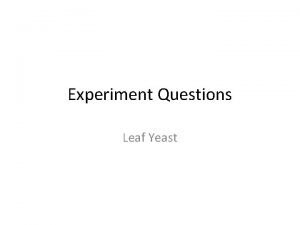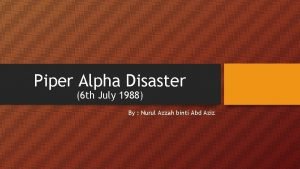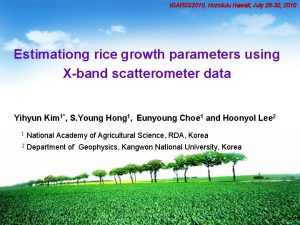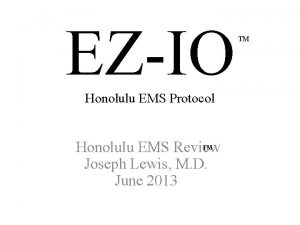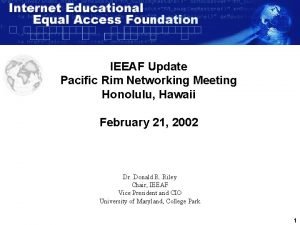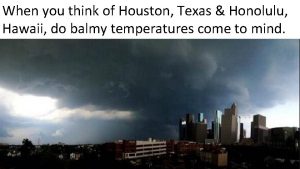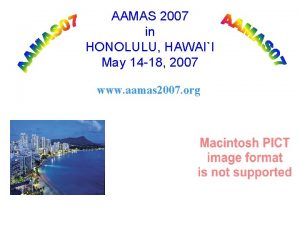IGARSS 2010 Honolulu Hawaii July 25 30 2010






















- Slides: 22

IGARSS 2010, Honolulu Hawaii, July 25 -30, 2010 Estimationg rice growth parameters using X-band scatterometer data Yihyun Kim 1*, S. Young Hong 1, Eunyoung Choe 1 and Hoonyol Lee 2 1 National Academy of Agricultural Science, RDA, Korea 2 Department of Geophysics, Kangwon National University, Korea

Contents 1 Background 2 Material and Methods 3 Results 4 Conclusion

Background q Rice is one of the major crops in Korea q Microwave radar can penetrate cloud cover regardless of weather condition q Ground-based polarimetric scatterometer has advantage of monitoring crop conditions with full polarization and various frequencies q Plant parameters such as LAI, biomass, plant height are highly correlated with backscattering coefficients q ENVISAT SAR data (5. 3 GHz, hh-, hv-polarizations, and incidence angles between 28. 5° and 40. 9°) to monitor rice growth and compared the data with simulation results (Le Toan et al, 1997)

Background q RADARSAT data (5. 3 GHz, hh-polarization, and incidence angles between 36° and 46°) was analyzed for monitoring the rice growth in Korea (Hong et al, 2000) q Backscattering coefficients from a ground scatterometer are often affected by weather condition the necessity of near-continuous automatic measurement has arisen by the experiment in 2007 (Kim et al, 2008)

Objective l To analyze scattering characteristics of paddy rice obtained from L, C, X-band automatic scatterometer system l Relationship between backscattering coefficients in L, C, X-band plant parameters with full polarization l Prediction of rice growth parameters using backscattering coefficients in L, C, X-band

q Study site - An experimental field at NAAS, Suwon, Korea Ø Testing varieties : Chuchoungbyeo Ø The size field : 660 m 2

Materials and Methods q L, C, X-band automatic scatterometer system X-band C-band L-band Ø Measurement Interval : 1 per 10 minutes

Materials and Methods q Specification of the L, C, X-band automatic scatterometer system Specification L-Band C-Band X-Band Center frequency 1. 27 GHz 5. 3 GHz 9. 65 GHz Bandwidth 0. 12 GHz 0. 6 GHz 1 GHz 201 801 1601 Antenna type Dual polarimetric horn Antenna gain 12. 4 d. B 20. 1 d. B 22. 4 d. B Range resolution 1. 25 m 0. 15 m Wavelength 0. 23 m 0. 056 m 0. 031 m Polarization HH, VV, HV, VH 4. 16 m Number of frequency points Platform height

q Radar backscattering measurement - Between before transplanting(17 May, 2009) and harvesting stage(12 Oct, 2009) q Growth data collection - Leaf Area Index, Plant height, Fresh and Dry weight etc. Transplant stage (mid-May) Heading stage (mid-Aug) Panicle formation stage (mid-July) Harvesting stage (mid-Oct)

q Calculation of backscattering coefficients (apply to radar equation) v Backscattering coefficients of X-band the follow expression

Results 110 5. 0 100 4. 5 90 4. 0 80 3. 5 70 heading stage 3. 0 60 LAI planh height(cm) q Temporal variations in growth parameters during rice growth 50 2. 5 2. 0 40 1. 5 30 20 1. 0 10 0. 5 0. 0 0 0 10 20 30 40 50 60 70 80 90 100110120130140150 DAT(Day After Transplanting) <Plant height> 0 10 20 30 40 50 60 70 80 90 100 110 120 130 140 150 DAT(Day After Transplanting) <Leaf Area Index>

Results q Temporal variations in growth parameters during rice growth heading stage 200 400 180 350 300 Dry biomass(g/m 2) Fresh biomass(g/m 2) 160 250 200 150 100 140 120 100 80 60 40 50 20 0 10 20 30 40 50 60 70 80 90 100110120130140150 DAT(Day After Transplanting) <Fresh biomass> 0 10 20 30 40 50 60 70 80 90 100 110 120 130 140 150 DAT(Day After Transplanting) <Dry biomass>

Results q Temporal variations of backscattering coefficients at polarization and incident angle 45° for the L-band 0 -5 scatt. coeff. (d. B) -10 -15 -20 -25 -30 -35 -40 VV VH HV HH -45 -50 -55 140 150 160 170 180 190 200 210 220 230 240 250 260 270 280 290 DOY(Day of year) booting stage ~ heading stage (most active rice growth period)

Results q Temporal variations of backscattering coefficients at polarization and incident angle 45° for the C-band 0 -5 scatt. coeff. (d. B) -10 -15 -20 -25 -30 -35 -40 VV -45 VH -50 HV HH -55 140 150 160 170 180 190 200 210 220 230 240 250 260 270 280 290 DOY(Day of year)

Results q Temporal variations of backscattering coefficients at polarization and incident angle 45° for the X-band 0 -5 scatt. coeff. (d. B) -10 -15 -20 -25 -30 -35 -40 VV VH HV HH -45 -50 -55 140 150 160 170 180 190 200 210 220 230 240 250 260 270 280 290 DOY(Day of year)

Results q Relationship between backscattering coefficients at L, C, X-band plant variables v L-band VV HH HV Incident angle Plant Height LAI Tfw (g/m 2) Gdw (g/m 2) Plant height LAI Tfw (g/m 2) Gdw (g/m 2) 45 0. 80** 0. 91*** 0. 90*** -0. 78** 0. 89*** 0. 98*** 0. 96*** -0. 74** 0. 79** 0. 93*** 0. 89*** -0. 62* v C-band VV HH HV Incident angle Plant height LAI Tfw (g/m 2) Gdw (g/m 2) 45 0. 60* 0. 86** 0. 75** -0. 78** 0. 70** 0. 92*** 0. 83** -0. 83** 0. 77** 0. 91*** 0. 89*** -0. 72** v X-band VV HH HV Incident angle Plant height LAI Tfw (g/m 2) Gdw (g/m 2) 45 0. 63* 0. 66* 0. 73** 0. 94*** 0. 72** 0. 81** 0. 84** 0. 79** 0. 68* 0. 83** 0. 70*

Results q Optimum condition for estimation of rice growth parameters Optimum condition Band Polarization R 2 Plant height(cm) L-band HH R 2=0. 86*** Leaf Area Index L-band HH R 2=0. 96*** Above ground L-band HH R 2=0. 94*** Grain X-band VV R 2=0. 91*** X-band VV R 2=0. 94*** Growth parameters Fresh Biomass(g/m 2) Grain dry weight(g/m 2)

Results q Prediction of Leaf Area Index using backscattering coefficients(L-band, HH) 5. 0 4. 5 4. 0 = 0. 9624 Predicted LAI by modeling('09) R 2 3. 5 LAI 3. 0 2. 5 2. 0 1. 5 1. 0 0. 5 4. 5 y = 0. 8739 x + 0. 4459 4. 0 R 2 = 0. 95*** RMSE = 0. 2346 3. 5 3. 0 2. 5 2. 0 1. 5 1. 0 0. 5 0. 0 -35 -30 -25 -20 -15 -10 -5 Backscattering coefficients(L-band, HH, d. B) 0 0. 5 1. 0 1. 5 2. 0 2. 5 3. 0 Measured LAI('08) 3. 5 4. 0 4. 5 5. 0

Results q Prediction of Biomass using backscattering coefficients (L-band, HH) 400 Total fresh weight(g/m 2) 350 Estimated total fresh weight by modeling(09) 450 R 2 = 0. 9129 300 250 200 150 100 50 0 -40 -35 -30 -25 -20 -15 -10 -5 Backscattering coefficients(L-band, HH, d. B) 0 y = 1. 0028 x – 0. 5471 400 R 2 = 0. 95*** 350 RMSE = 8. 5412 300 250 200 150 100 50 0 0 50 100 150 200 250 300 Measured total fresh weight(08) 350 400

Results q Prediction of Grain dry weight using backscattering coefficients (X-band, VV) Grain dry weight(g/m 2) 40 Predicted grain dry weight by modeling('09, g/m 2) 45 R 2 = 0. 9345 35 30 25 20 15 10 -20 -19 -18 -17 -16 -15 -14 -13 Backscattering coefficients (X-band, VV, d. B) -12 40 y = 1. 1099 x – 1. 3067 35 R 2 = 0. 96*** RMSE = 1. 7685 30 25 20 15 10 10 15 20 25 30 35 Measured grain dry weight ('08, g/m 2) 40

Conclusions Backscattering coefficients of rice crop were investigated with an automatically -operating ground-based scatterometer The temporal variations of the backscattering coefficients of the rice crop at L, C, X-band during rice growth period HH-polarization backscattering coefficients higher than VV-polarization backscattering coefficients after effective tillering stage(mid-June) Relationships between backscattering coefficients and the rice growth parameters Biomass, LAI was correlated with HH-backscattering coefficients in L-band X-band was sensitive to grain maturity at near harvesting season Prediction of rice growth parameters using backscattering coefficients in L, C, X-band

 Baton rouge to indianapolis
Baton rouge to indianapolis Honolulu cookie company whalers village
Honolulu cookie company whalers village Honolulu vpn
Honolulu vpn Leaf yeast experiment
Leaf yeast experiment July 30 2009 nasa
July 30 2009 nasa January march april may june july
January march april may june july Another place another time harris burdick
Another place another time harris burdick July 4 sermon
July 4 sermon Poppies in july imagery
Poppies in july imagery Hurrah for the fourth of july cartoon
Hurrah for the fourth of july cartoon July 12 1776
July 12 1776 Diferença entre eclipse lunar e solar
Diferença entre eclipse lunar e solar 6th july 1988
6th july 1988 July 26 1953
July 26 1953 Sources nso frenchhowell neill mit technology...
Sources nso frenchhowell neill mit technology... Harris burdick pictures uninvited guest
Harris burdick pictures uninvited guest June too soon july stand by
June too soon july stand by Gdje se rodio nikola tesla
Gdje se rodio nikola tesla 2001 july 15
2001 july 15 The hot july sun beat relentlessly down
The hot july sun beat relentlessly down July 14 1789
July 14 1789 Monday 13th july
Monday 13th july July 16 1776
July 16 1776



